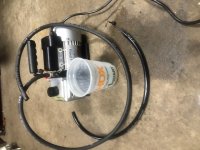Well, the results are in. The plastic syringe method was a messy failure. The oil is just too thin to permit a reasonable amount of time to transition from drain screw to syringe and back. Once on, the syringe does a fine job of filling the fork with oil as long at the schrader valve from the air hose is removed, which allows the air you're displacing to escape, but the transition from screw to syringe and back is impossible. Luckily, I had a bucket underneath to catch all of the spillage, weighed it, and added it back along with another ounce and a half using the VACUUM METHOD! Yes, Ronco shoppers (showing your age if you know what that reference means), the vacuum pump method worked like a charm.
I removed the schrader valve from the air port and hooked a vacuum pump (usually used to evacuate automobile air conditioning systems) to it using a rubber hose. I used another rubber hose with a taper fitting on the end to suck the fluid out of a measuring cup (I weighed the fluid, not eyeball measure). It sucked it all in, pulled out the hose, nothing came out while the pump was running. I quickly started the drain screw threads and then switched off the pump. Not a drop was spilled. I then used the same method to suck an ounce and a half into the other side. Again, not a drop spilled. No fluid went up through the vacuum hose into the pump. There is enough air in there, and the fluid is thin enough that it doesn't travel up that far. I'll post some pics of my equipment in a little while.
From now on, I'm going to do regular fork oil changes using this method on all of my bikes. The only requirement is that they need to have some sort of air assisted front forks.

I have no idea why it's flipping this photo 90 degrees. If anyone does, let me know how to correct it.


